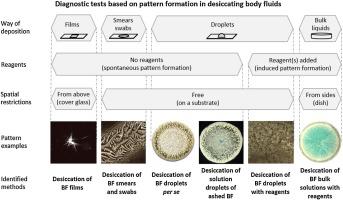Colloids and Surfaces B: Biointerfaces ( IF 5.4 ) Pub Date : 2021-09-01 , DOI: 10.1016/j.colsurfb.2021.112092 Maria Olga Kokornaczyk 1 , Natalia Borisovna Bodrova 2 , Stephan Baumgartner 3

|
There are numerous diagnostic tests based on pattern formation in desiccating body fluids, where the pattern or some of its characteristics constitute the diagnostic test outcome. However, partially due to the development in different time periods, and partially due to publications in languages different from English, most of these diagnostic tests exist as separate approaches and have never been grouped, systematized, nor compared with each other. In the present mapping review, we performed a wide literature search with the aim to collect all diagnostic tests based on pattern formation in desiccating body fluids. Furthermore, we grouped the identified diagnostic tests according to their experimental protocols, type of body fluids investigated, and target conditions, and propose so for the first time a classification of different diagnostic tests based on pattern formation in desiccating body fluids. The literature search revealed 1603 publications, out of which 141 were included into the review. Following three main classification criteria (way of deposition of the fluid for desiccation, addition of reagents, and spatial restrictions during evaporation), we identified six different methods; following a further classification concerning the analyzed body fluid we identified 30 different diagnostic tests based on pattern formation in evaporating body fluids. Amongst these tests are well-known procedures such as ferning tests (tear ferning for the assessment of tear film quality, saliva and cervical mucus ferning for the detection of the fertile period, and amniotic fluid ferning for the diagnosis of fetal membrane rupture), whereas other tests are less well-established. In the latter group, the most frequently investigated body fluids were serum, saliva, and blood; the most frequently addressed target conditions were cancer, inflammation, and benign tumors. We recommend conducting further systematic reviews and meta-analyses concerning groups of methods addressing the same target condition.
中文翻译:

基于干燥体液模式形成的诊断测试——映射审查
有许多基于干燥体液模式形成的诊断测试,其中模式或其某些特征构成了诊断测试结果。然而,部分由于不同时期的发展,部分由于与英语不同语言的出版物,这些诊断测试大多作为单独的方法存在并且从未被分组、系统化或相互比较。在本图谱审查中,我们进行了广泛的文献搜索,目的是收集所有基于干燥体液模式形成的诊断测试。此外,我们根据实验方案、研究的体液类型和目标条件对确定的诊断测试进行了分组,并首次提出基于干燥体液模式形成的不同诊断测试的分类。文献检索揭示了 1603 篇出版物,其中 141 篇被纳入综述。遵循三个主要分类标准(用于干燥的流体沉积方式、添加试剂和蒸发过程中的空间限制),我们确定了六种不同的方法;在对分析的体液进行进一步分类之后,我们根据蒸发体液的模式形成确定了 30 种不同的诊断测试。在这些测试中,有众所周知的程序,例如蕨类植物试验(用于评估泪膜质量的撕裂蕨类植物,用于检测生育期的唾液和宫颈粘液蕨类植物,和羊水蕨用于诊断胎膜破裂),而其他测试则不太完善。在后一组中,最常研究的体液是血清、唾液和血液;最常解决的目标病症是癌症、炎症和良性肿瘤。我们建议对针对同一目标条件的多组方法进行进一步的系统评价和荟萃分析。











































 京公网安备 11010802027423号
京公网安备 11010802027423号